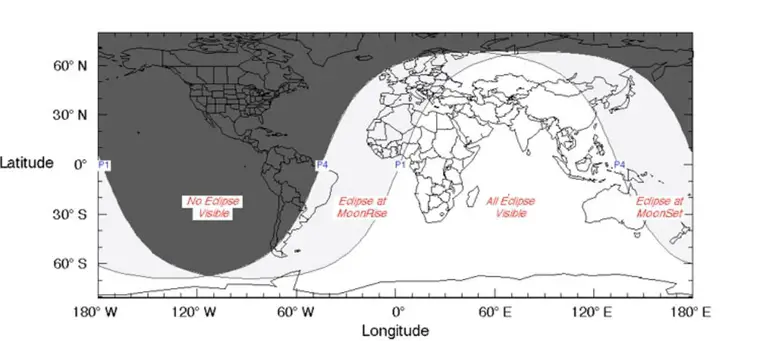(Elias Marat) We are in for a major spectacle this Friday as we’ll be treated to June’s full “Strawberry Moon” in all of its glory.
by Elias Marat, June 4th, 2020
North America and most of the Western Hemisphere is in store for a major spectacle this Friday as we’ll be treated to June’s full “Strawberry Moon” in all of its glory.
And for much of the world, the June Full Moon will also coincide with a dazzling kickoff of the second eclipse season of year, with a penumbral lunar eclipse lasting over 3 hours.
NASA reports that the full moon will become visible on June 5 at 3:12 p.m. EDT, or 8:12 p.m. for people in the U.K.
“The Moon will appear full for about three days around this time, from early Thursday morning into early Sunday morning,” the space agency’s website explains.
Get ready for the full 'strawberry' moon on Friday! pic.twitter.com/w95obbvZl8
— Physics-astronomy.org (@OrgPhysics) June 2, 2020
The strawberry moon’s name isn’t derived from any expected color of the moon, but instead comes from Indigenous northeastern North Americans’ name for the relatively short strawberry growing season. The name is recognized by most Algonquin tribes and was passed along to colonial settlers.
Other names for the full moon include the rose moon, flower moon, planting moon, hot moon, honey moon, and mead moon.
“Mead is a drink created by fermenting honey mixed with water, sometimes with fruits, spices, grains, or hops,” NASA continued. The agency explained:
“The tradition of calling the first month of marriage the ‘honeymoon’ dates back to at least the 1500’s and may be tied to this full Moon, either because of the custom of marrying in June or because the ‘Honey Moon’ is the ‘sweetest’ Moon of the year.
Book Forgotten Civilization: The Role of Solar Outbursts in Our Past and Future
“Some writings suggest that the time around the Summer solstice at the end of June was when honey was ripe and ready to be harvested from hives or from the wild, which made this the ‘sweetest’ Moon.”
The June full moon also has a long and celebrated significance for Hindus and Buddhists.
THREAD 1 : 5th June 2020 – LUNAR ECLIPSE
Eclipses hold a crucial place in our religion and astrology. We are experiencing a penumbral Lunar eclipse on June 5. You may wonder what is penumbral lunar eclipse.
There are 3 types of lunar eclipse-
full, partial and penumbral. pic.twitter.com/XsPJJZUlmc— Pt. Gajanan Krishna Maharaj (Astro- Counsellor) (@Gkmastrology) June 4, 2020
“June was traditionally the month of marriages, and is even named after the Roman goddess of marriage, Juno. Following marriage comes the ‘honeymoon,’ which may be tied to this full Moon’s name!,” the Old Farmer’s Almanac explained:
However, while the moon will be shining brilliantly in North America, people in other parts of the world will be treated to an entirely different lunar display – a penumbral lunar eclipse that will render the moon “dark and silvery,” reports LiveScience.
The penumbral lunar eclipse is different than a partial or total lunar eclipse. In this case, the Earth will be placed between the Sun and the moon, forming a line that is not entirely straight. As a result, the Earth will be blocking sunlight from reaching the moon’s surface and will form a somewhat pale shadow called the penumbra.
According to Universe Today, most of Europe, Brazil, and western Africa and will see the eclipse underway when the moon rises Friday night, while the remainder of Africa and most of Asia will see the entirety of the eclipse. Northeast Asia, New Zealand, and Australia will witness the eclipse toward dawn when the moon is setting. Sadly, North America and South America will miss out on this eclipse.

The eclipse will last three hours, 18 minutes and 13 seconds. In total, however, it will take 19 hours for it to complete its cycle.
Astrophysicist Dr. David Gozzard of the University of Western Australia International Centre for Radio Astronomy Research told the Daily Mail that Aussies will be able to see the eclipsed full moon without any need for binoculars or a telescope, explaining:
“Because it’s going to last about three hours that means it’s going to be peaking around twilight, so around dawn, when the sun is getting up.
“The full moon is going to be quite high in the sky so it’ll be reasonably obvious. Anywhere you can get out and see the sky and see the moon will be a good place to see it from, as long as you can get a reasonably unobstructed view to the west.”
Other lunar eclipses due to occur this year will happen in July and November, both of which will also be penumbral ones.
Stillness in the Storm Editor: Why did we post this?
The news is important to all people because it is where we come to know new things about the world, which leads to the development of more life goals that lead to life wisdom. The news also serves as a social connection tool, as we tend to relate to those who know about and believe the things we do. With the power of an open truth-seeking mind in hand, the individual can grow wise and the collective can prosper.
– Justin
Not sure how to make sense of this? Want to learn how to discern like a pro? Read this essential guide to discernment, analysis of claims, and understanding the truth in a world of deception: 4 Key Steps of Discernment – Advanced Truth-Seeking Tools.
Stillness in the Storm Editor’s note: Did you find a spelling error or grammatical mistake? Send an email to [email protected], with the error and suggested correction, along with the headline and url. Do you think this article needs an update? Or do you just have some feedback? Send us an email at [email protected]. Thank you for reading.
Source:

Leave a Reply